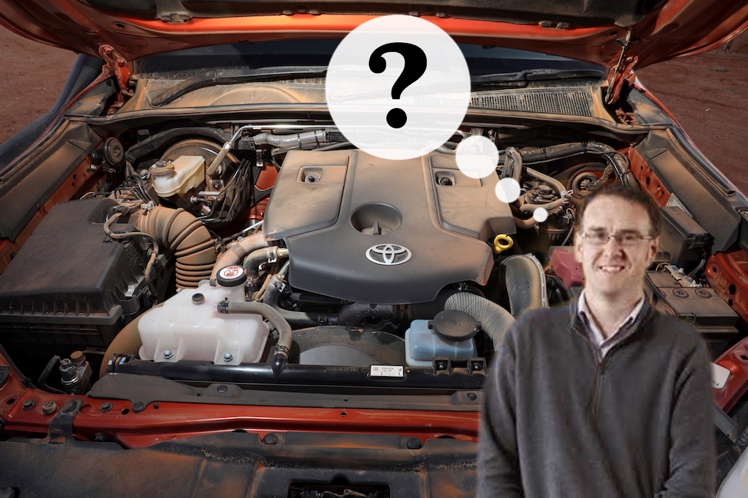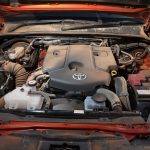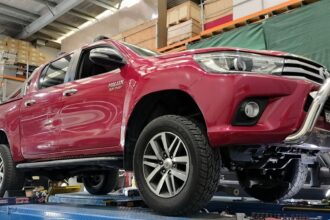Many folks reading this fine publication have been dismayed that Toyota’s most popular 4WD engine, the 2.8 litre 1GD-FTV, might have a serious problem with dust getting past the air filter system.
As we revealed only yesterday, there is enough dust getting past (or around) the engine’s air filter to cause problems with the MAF sensor. This then puts the vehicle into limp mode, and the driver is urged to take it directly to a dealer.
This is a problem we’ve experienced directly, during our Outback 4X4 ute comparison. The HiLux Rugged X went into limp mode a few times, which we fixed temporarily with a ‘bush reset’, disconnecting the main battery to reset the ECU.
Toyota has acknowledged the problem, telling us it can be managed by more frequent filter changes and some compressed air onto the MAF sensor every now and then. They have also said it’s not something worthy of a recall, and some kind of redesign is in the works with an unknown timeline.

A Toyota spokesperson told us the dust getting through to the clean side of the filter isn’t a problem for the engine, saying:
“The dust that makes its way through the filter is very fine and typically less than 5 microns in size. What can occur is that these very fine particles attach themselves to the sensor electrostatically. It is not an issue of the dust finding their way into any internal components of the MAF sensor,” the Toyota spokesperson said.
Toyota played down any chance of engine damage from the issue.
“The dust particle size that passes through the air intake system can become statically charged and adhere to the MAF sensor. The size of these particles is around two microns. In general, this type of very fine dust is not known to cause engine damage.”

We weren’t so sure about what Toyota said, so we reached out to an expert. We contacted Ben Mullins from Curtin University. Ben is an associate professor with special interest in testing and researching automotive filtration systems. Fuel, air, oil, gasses, and anything in between; the man knows filters.
We asked Ben to pass his eye over Toyota’s statements, and see if they held up with him. Here is what he said:
“I am surprised by the comments from Toyota. Firstly, 5 microns is regarded as a “coarse” particle in the air pollution world. It has been shown that fine particles (e.g diesel soot) can cause engine wear. Soot particles are <300 nm (0.3 microns) in size – albeit at high quantities in the oil.”
In other words, if those dust particles are making their way into turbochargers and internal engine components, they will be definitely contributing an engine wearing out faster. Ben continues:
“Also, whomever made the comments about more frequent filter replacement/checks or compressed air cleaning is misguided. The issue here is probably the filter sealing rather than the filter itself, so disturbing the filter more frequently would likely make things worse. Proper tests would need to be done to see if the problem is the filter or the sealing, however flat panel filters can be difficult to seal, which is why heavy-duty engines generally don’t use them except for cabin air.”
In other words, constantly changing the filter isn’t going help if the filter system is ineffective. There is a chance that the filter housing isn’t sealing correctly, so dusty air is bypassing the filter. Ben, once again:
“Another common misconception is that changing your air filter more frequently is better for your engine. Air filters are not sieves, so capture the least amount of particles when new, and get better when they load with dust. So if the filter is the problem, changing it more often will let more dust through! Heavy vehicle manufacturers and filter manufacturers recommend changing filter based on pressure drop as this ensures both the longest filter lifespan and the least dust in your engine.”

In other words: thinking of your filter like a sieve or colander is too simplistic: filters have more complex capture efficiency rates for particular sized particles, which often improves as the filter loads up with dust. So, a lightly used air filter will catch more dust than a brand-spanker. Once the filter gets overloaded and you experience pressure-drop (the filter is blocking the correct amount of airflow), then it’s time to change your filter. Black smoke under load is often a good indicator of this.
In the end, we think the takeaway from this is that Toyota’s problem with dust sealing and filtering is more serious than they are letting on. How much of a problem it is depends on how dusty your driving is, and how many kilometres you want to get out of your motor. If you’re driving really dusty roads regularly and want maximum lifetime out of your engine, you might want to look at a replacement filter setup with better specifications.
What do you think? Let us know in the comments below.










Ouch, this shouldn’t happen with today’s technology I bet their sale will drop especially when Toyota knew about this problem.
Can’t believe how shonky Toyota are being. I was looking at upgrading my current petrol Prado to either a Diesel Prado or 200 series this year but I think that the Y62 is looking better and better all the time. With the money saved will throw in a long range tank and be miles ahead.
Thousands of words yet not one picture of the actual problem. Any chance of an image of the problem area appearing at some point?